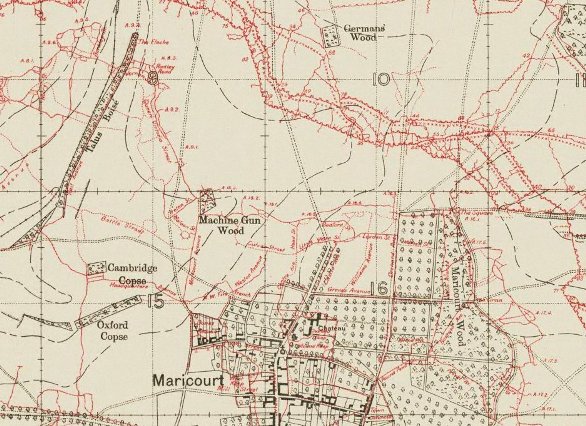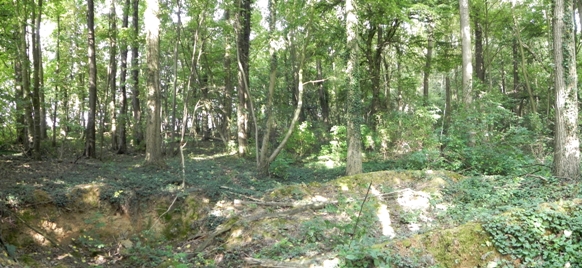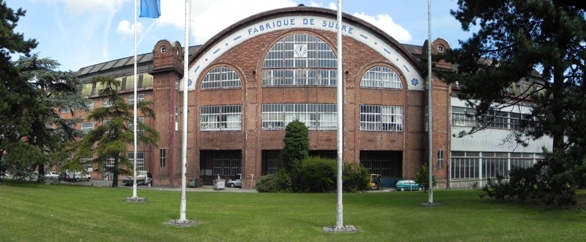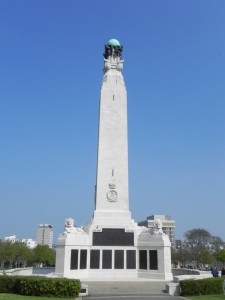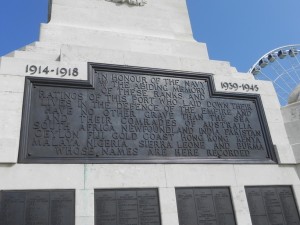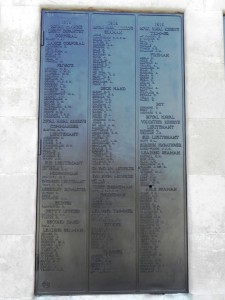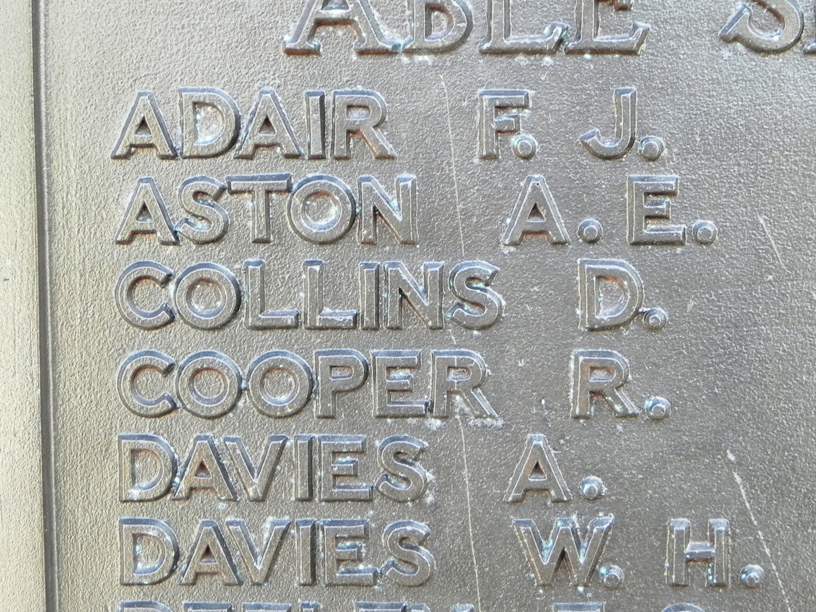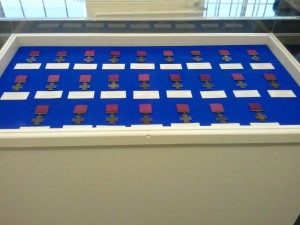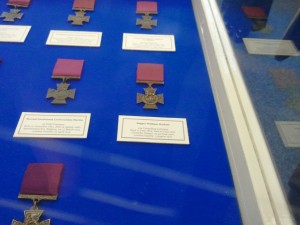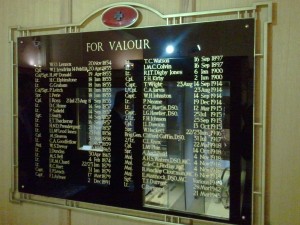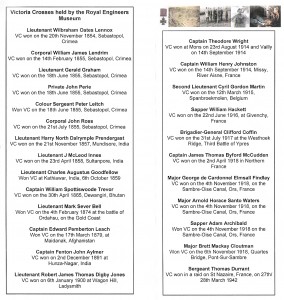Posts Tagged ‘Victoria Cross’
Blue plaque unveiled commemorating the life of Hardy Falconer Parsons VC, 14th Battalion, Gloucestershire Regiment
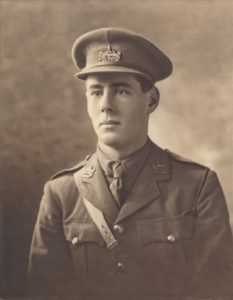
Second Lieutenant Hardy Falconer Parsons VC, 14th Gloucestershire Regiment. Image courtesy Soldiers of Gloucestershire Museum, Ref GLRRM:04750.6
Today saw the unveiling of a Bristol Civic Society blue plaque at the former Bristol home of my local Victoria Cross recipient, 2/Lt Hardy Falconer Parsons VC, 14th Gloucestershire Regiment. He lived a fifteen minute walk from my house and I have known his story for the past fourteen years that I have lived in the city.
My colleague Clive Burlton and I were determined to see Hardy’s strong association with Bristol and the West Country recognised. As his Government funded VC commemorative stone was unveiled in Rishton, Lancashire back in August we have spent the last year working on honouring Hardy’s local connections with a Bristol Civic Society blue plaque.
The plaque was unveiled by the Archie Smith and Grace Tyrrell, Head Boy and Head Girl of Kingswood School along with the Lord Mayor of Bristol, Cllr Lesley Alexander. The ceremony was attended by members of the Bristol Civic Society; the former Gloucestershire Regiment; the Soldiers of Gloucestershire Museum; the Bristol University Officer Training Corps; Kingswood School, Bath, Redland Green School and Dolphin Schools in Bristol; bandsmen from the Salamanca Band of the Rifles Regiment; members of the Western Front Association and the Bristol Great War network and representatives of the Kingswood Association, whose generous donation enabled the plaque to be made and installed. Also attending were the Deputy Lord-Lieutenant for the County and City of Bristol, Colonel Andrew Flint and the Dean of Bristol, the Very Rev Dr David Hoyle. In total, around 100 people were in attendance for the ceremony. Afterwards a sizeable number of us were invited back to the Artillery Grounds on Whiteladies Road for light refreshments as guests of Bristol University Officer Training Corps.
Images of the unveiling ceremony can found below, followed by the culmination of much detailed research into Hardy’s life by Clive Burlton and myself. I can only hope that the people of Bristol and Bath embrace his memory. He deserves that.
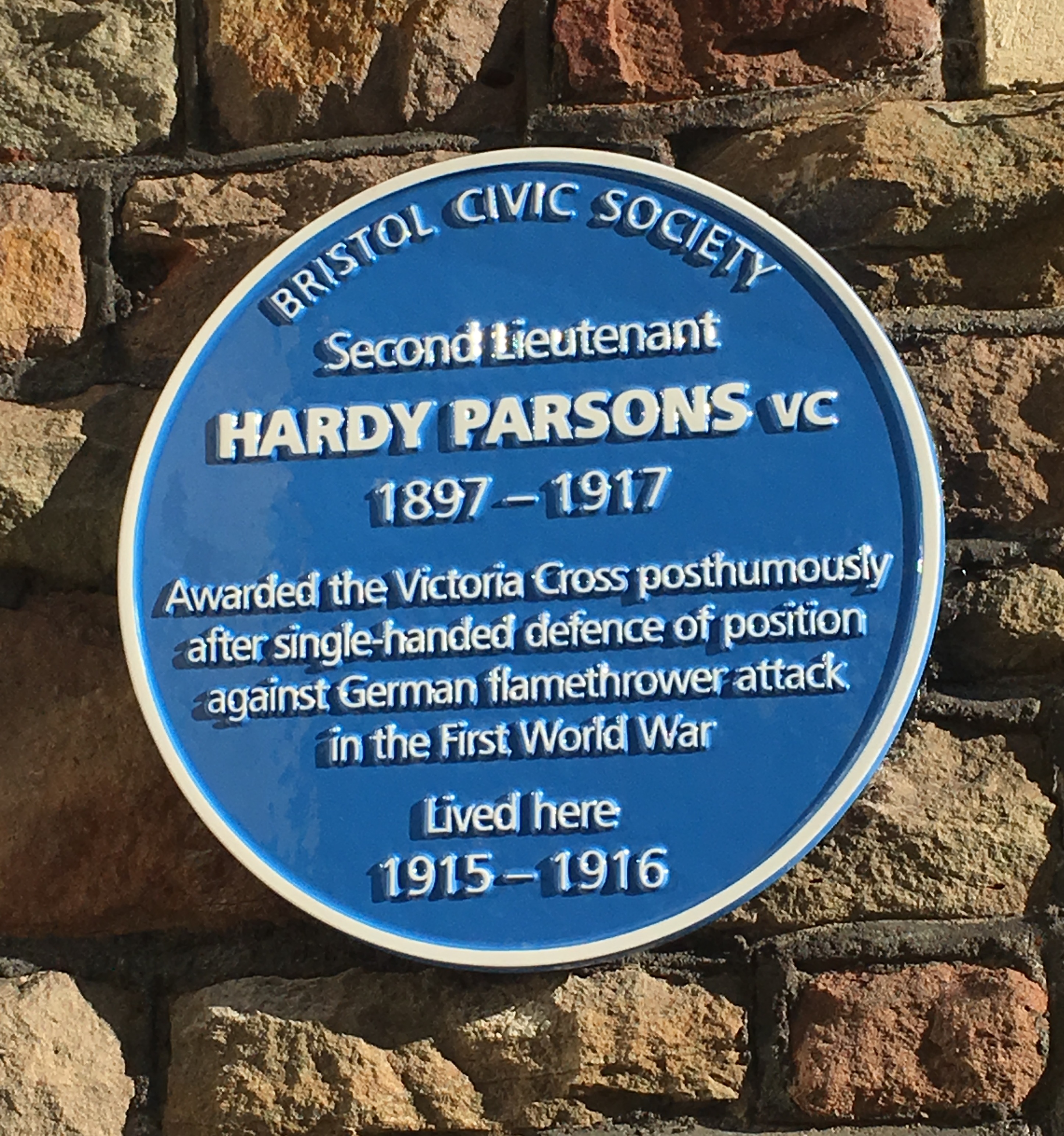
Blue plaque for Hardy Falconer Parsons VC at 54, Salisbury Road, Redland, Bristol
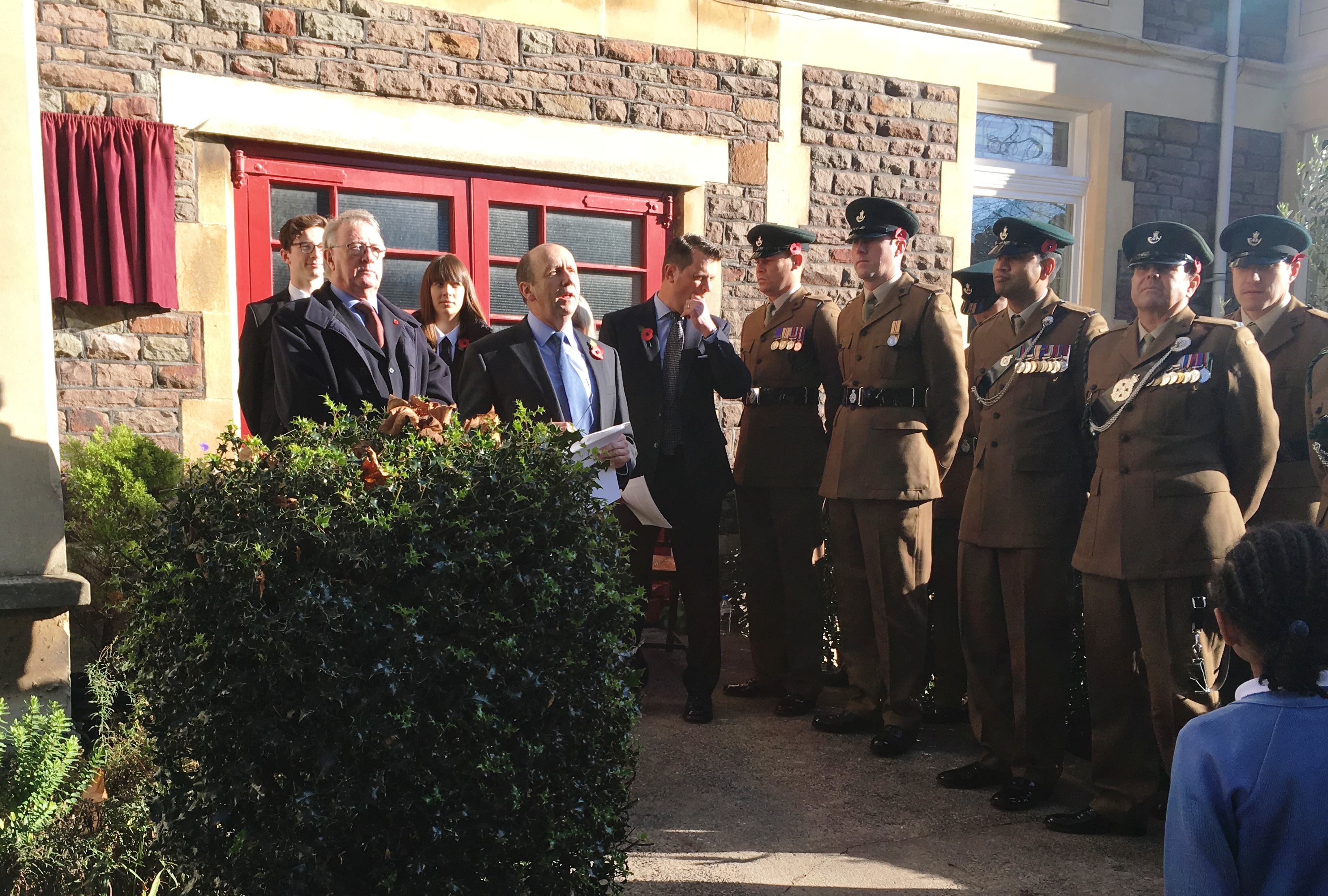
Clive Burlton gives the opening address
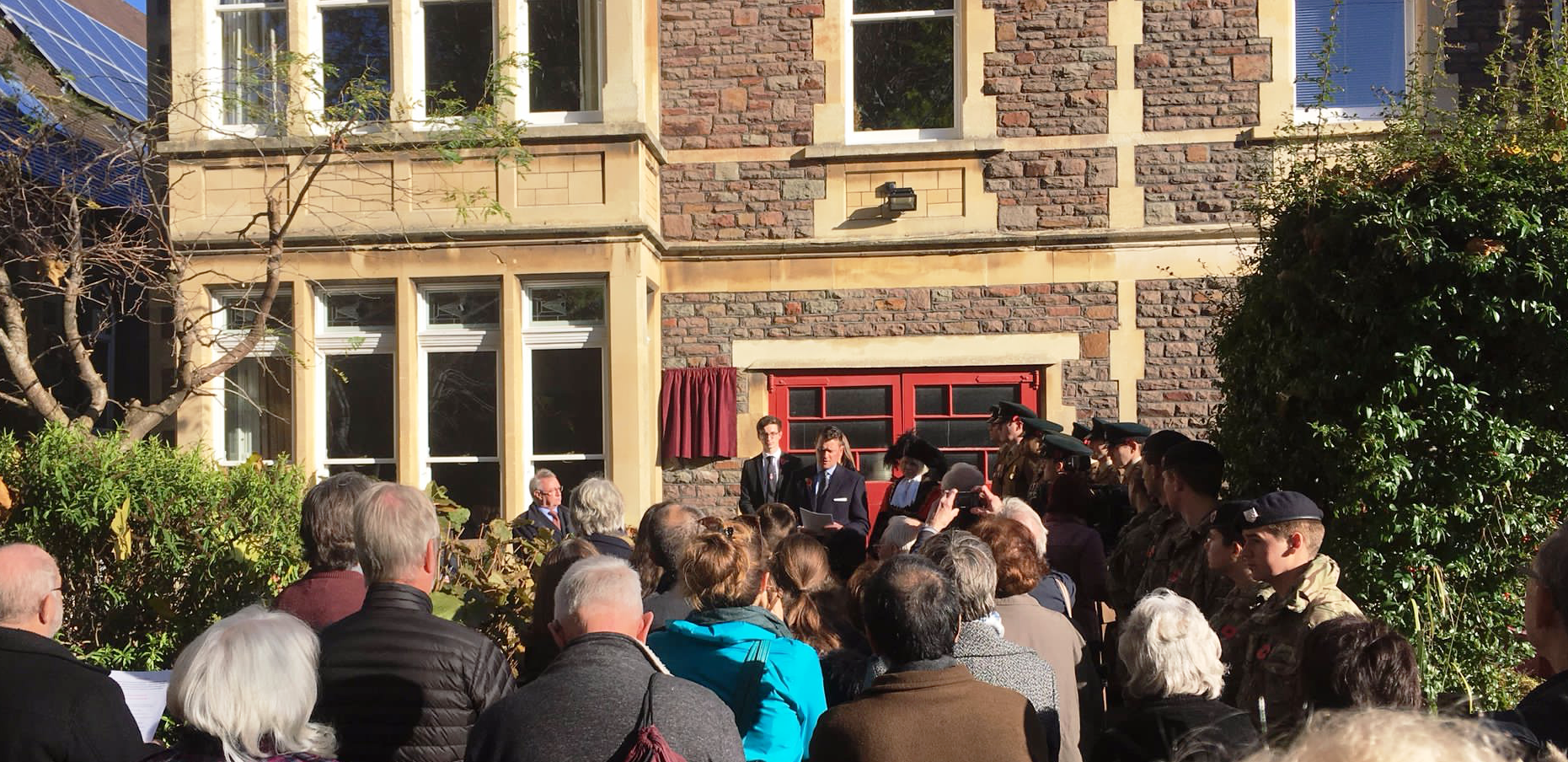
Jeremy Banning providing the historical background to the life of Hardy Falconer Parsons VC
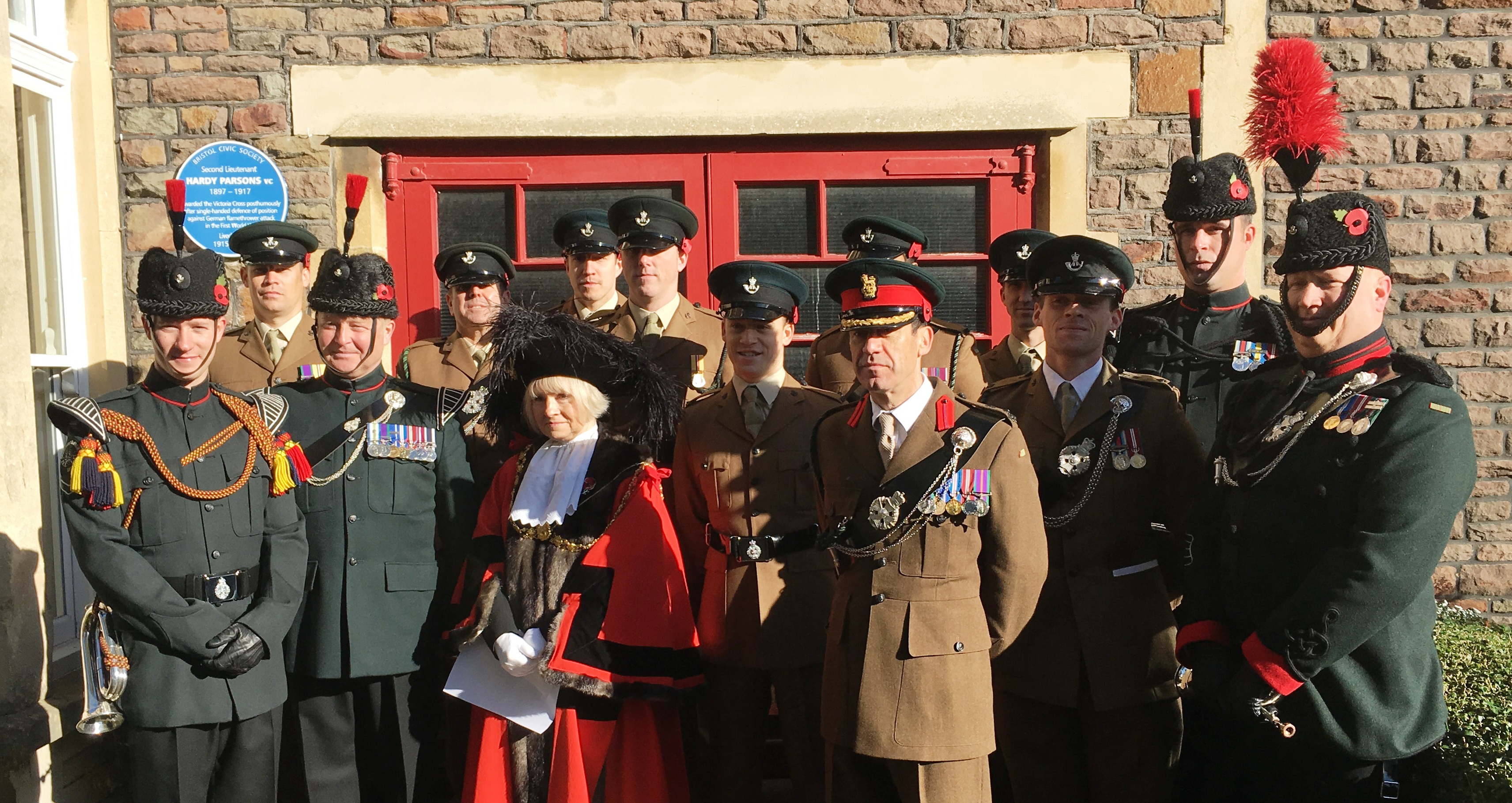
The Lord Mayor of Bristol with members of Bristol University Officer Training Corps and bandsmen from the Salamanca Band of the Rifles
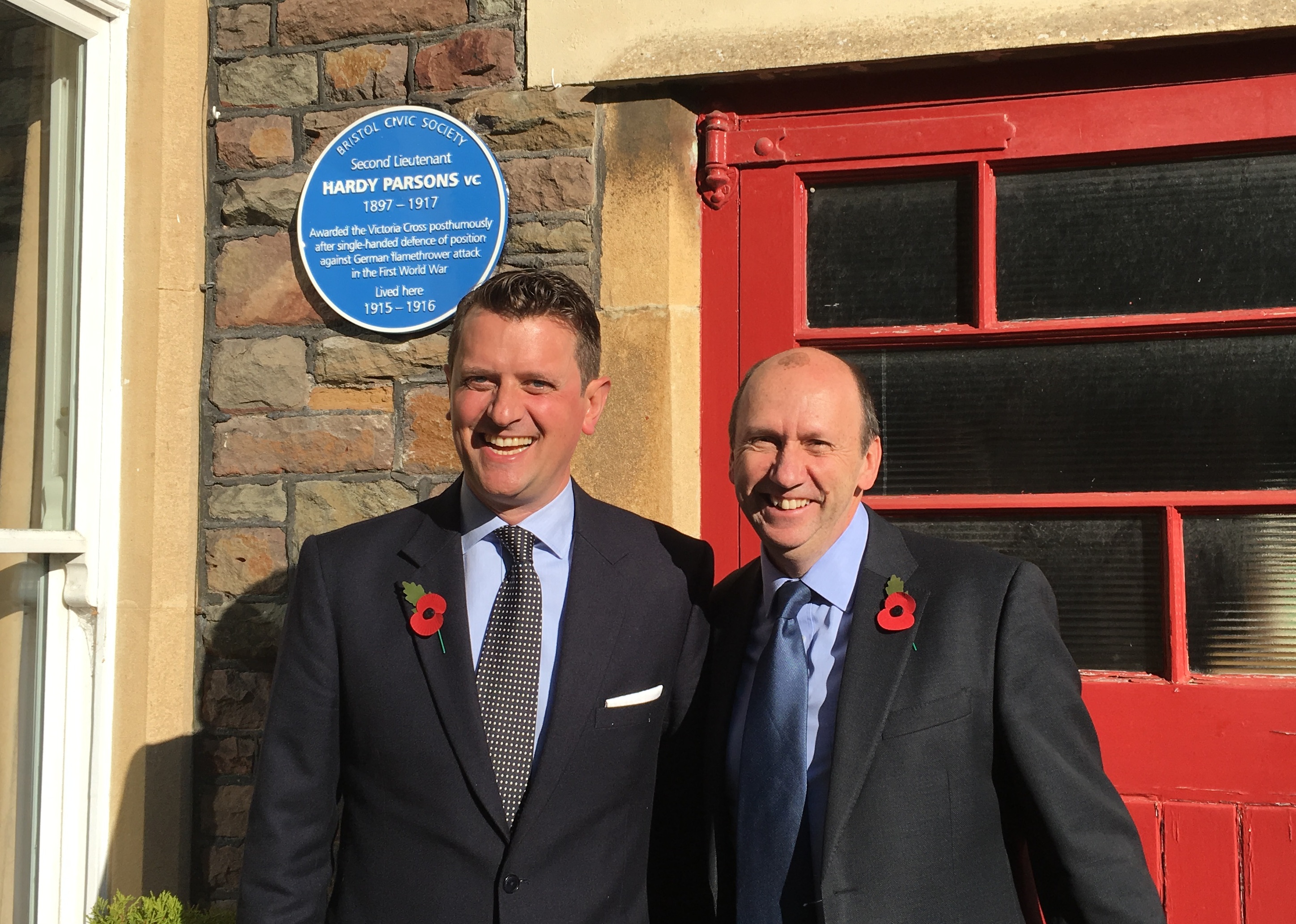
A delighted Jeremy Banning and Clive Burlton with Hardy’s new blue plaque
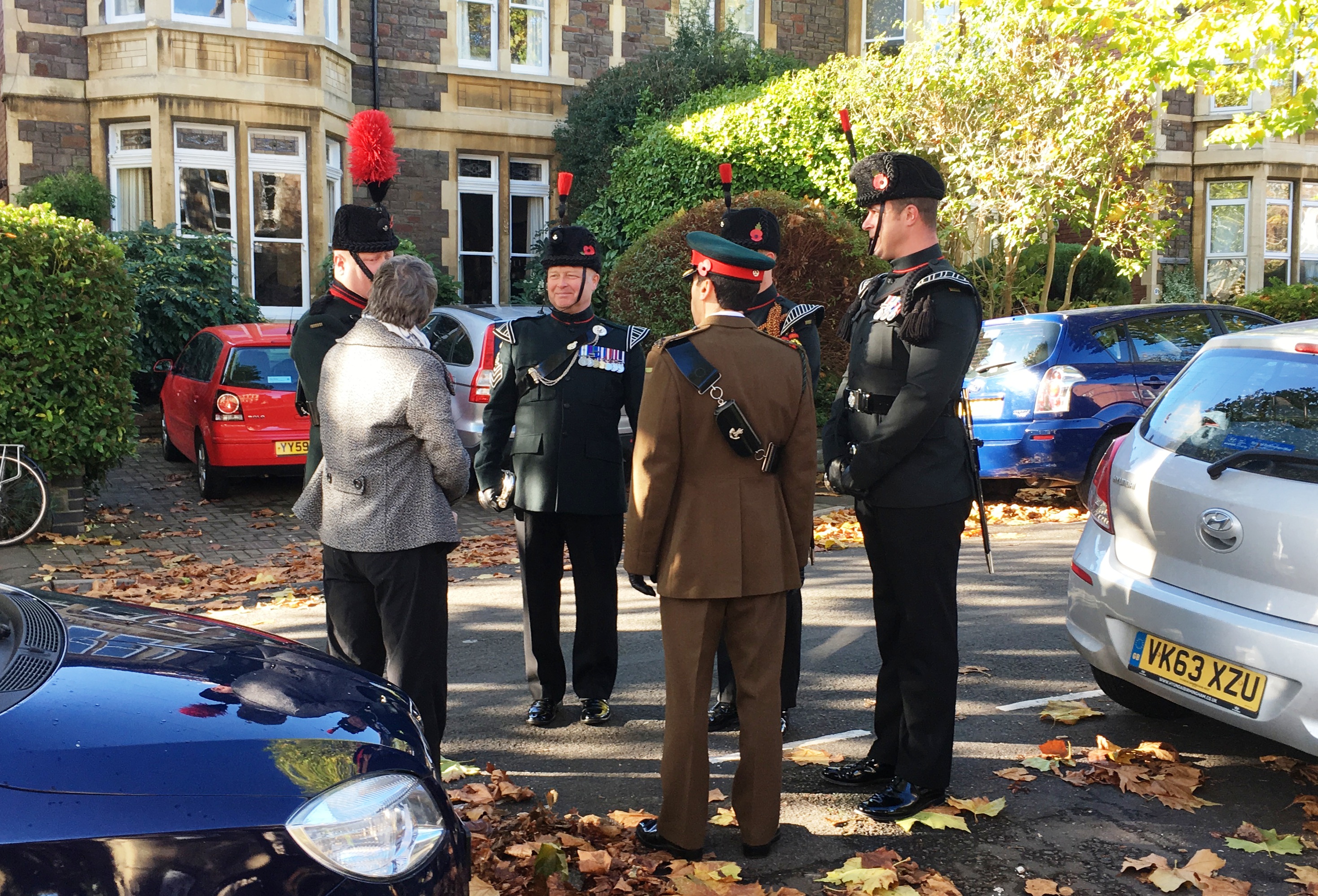
The ceremony was well attended by the military
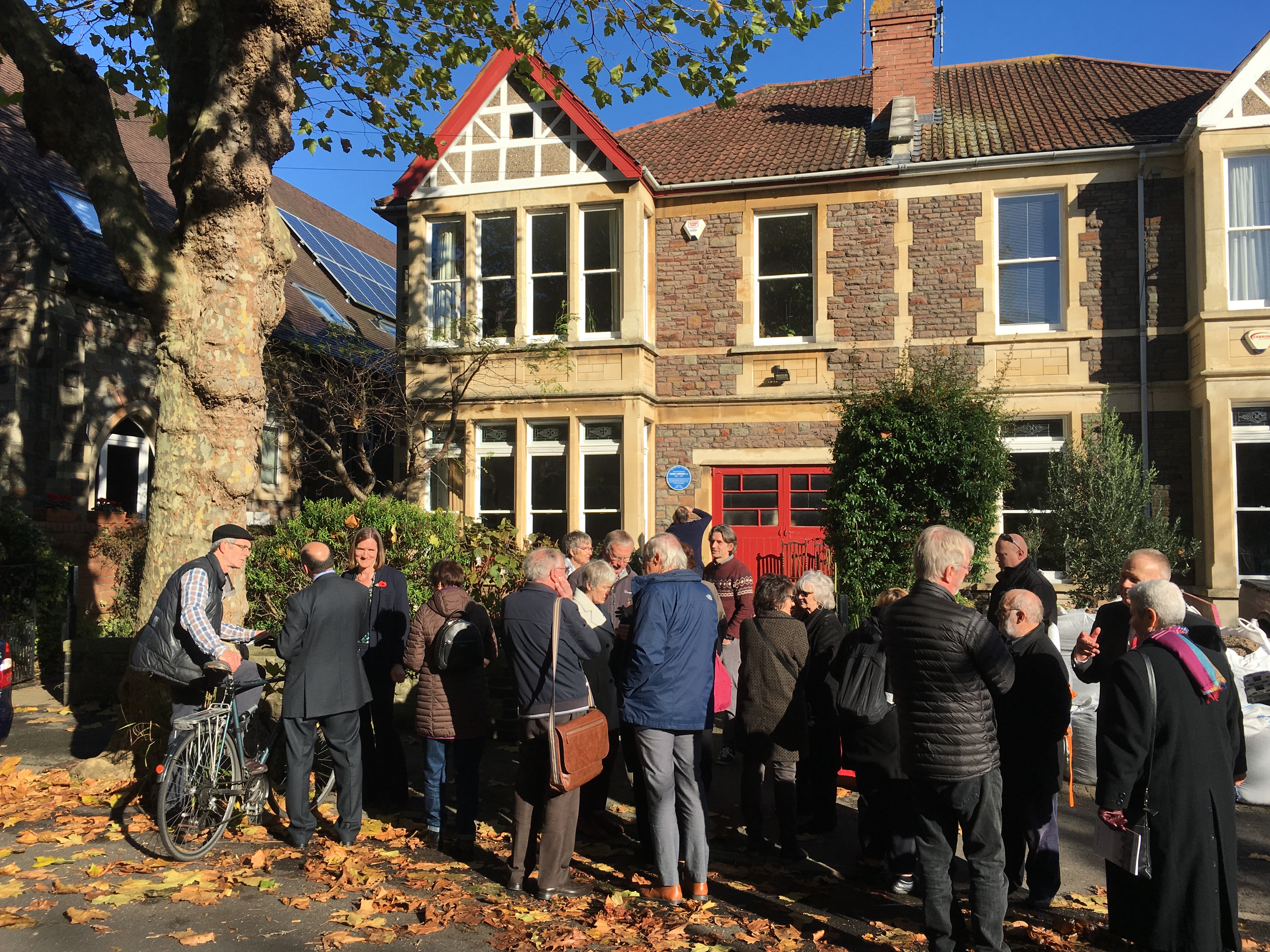
After the ceremony many of those attended were able to mingle and discuss Hardy’s life
Bristol 24/7 have also covered the story: https://www.bristol247.com/news-and-features/news/pictures-blue-plaque-revealed-wwi-soldier-redland/ as have BBC News: http://www.bbc.co.uk/news/uk-england-bristol-41918314. Our BBC Points West interview is available for a week from 16 minutes in here: https://www.bbc.co.uk/iplayer/episode/b09bzw5f/points-west-evening-news-08112017
The life of Hardy Falconer Parsons VC, 14th Battalion, Gloucestershire Regiment
Hardy Falconer Parsons was born on 30 June 1897 at Rishton, near Blackburn, Lancashire, the first of three boys. His father, the Rev James Ash Parsons, was a Wesleyan Minister whilst his mother Henrietta (known as Rita) was the daughter of a railway inspector from York. Hardy’s rather unusual middle name came from Rita – Falconer was her maiden name.
The Rev James Ash Parsons had spent eleven years in total in the slums of East London as superintendent of the Methodist Leysian Mission. Ill health forced him and Rita to St Anne’s on Sea, south of Blackpool and it was whilst living here that Hardy was born. There followed three years at Arnside immediately south of the Lake District. Clearly, the ethos of duty and service to others, so well practiced by his parents, was a huge part of Hardy’s upbringing.
Hardy’s first school was King Edward VII School at Lytham St Annes. From the paper work we have found it appears the family moved to Bristol in 1912 when the Rev James Ash Parsons became pastor at the Old King Street Wesleyan Chapel (sadly, now demolished). The family moved to 54 Salisbury Road in Redland and Hardy attended Kingswood School in Bath until April 1915.
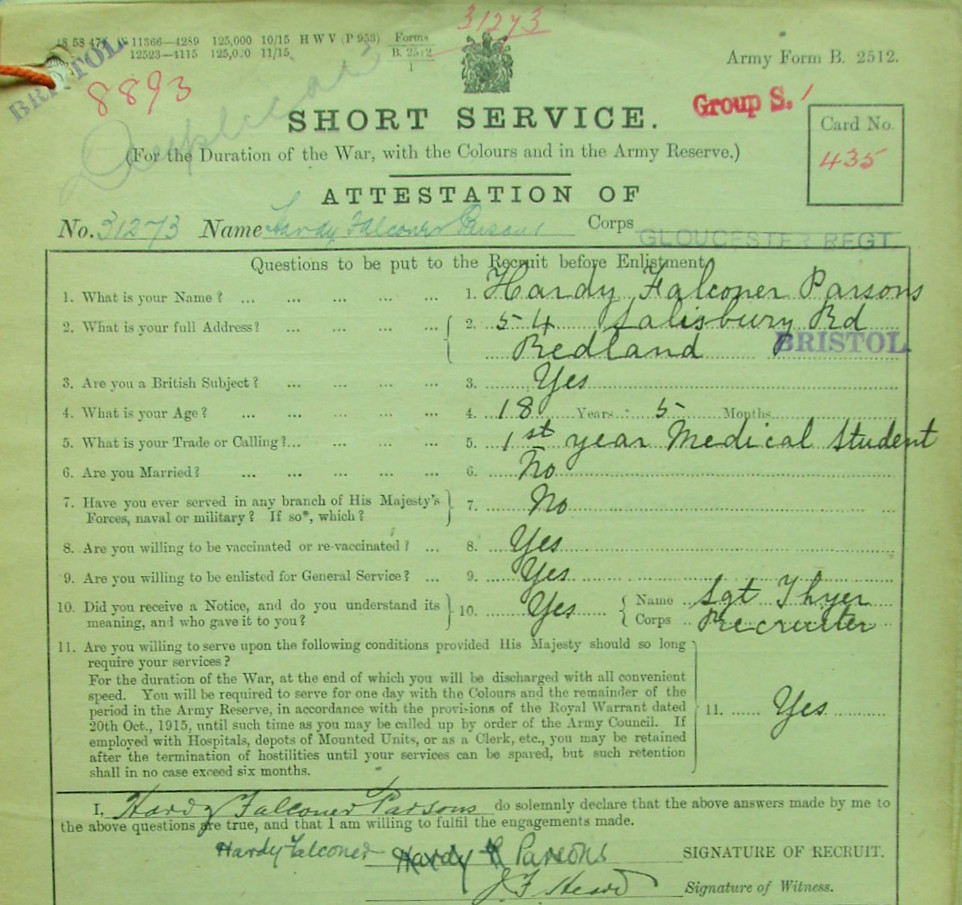
Extract from attestation papers of Hardy Falconer Parsons (National Archives: WO339/73298)
After school Hardy Parsons became a Medical Student at Bristol University with the aim of becoming a medical missionary. At the end of November 1915, during his first year at the University he signalled his wish to volunteer for service by attesting when aged just 18 years & 5 months but was immediately placed on the Army Reserve.
He had previously declined a safe post in a Government munitions laboratory, feeling that he ought not to withhold himself from the fullest sacrifice. He hated war, but recognised that the making of munitions was just as much war work as was the actual taking of life.
He joined the University’s Officer Training Corps in May 1916, a month shy of his 19th birthday, and then passed his first Bachelor of Medicine degree. His attestation papers make interesting reading – recording that he was a tall man, especially for that time, standing at 6ft ¾ inch tall. In early October 1916 he was posted to 6th Officer Cadet Battalion at Balliol College, Oxford and, on 25 January 1917, was appointed to the Gloucestershire Regiment as a Second Lieutenant.
He eventually joined the 14th Battalion in March, a unit which had previously been a ‘Bantam’ battalion – with men of 5ft 3 inches and less serving in its ranks. By the time the nearly 6ft 1 inch Hardy joined the battalion this unique distinction had been very much diluted. In February 1917 the battalion war diary records 475 ‘normal size men’ joining the battalion.
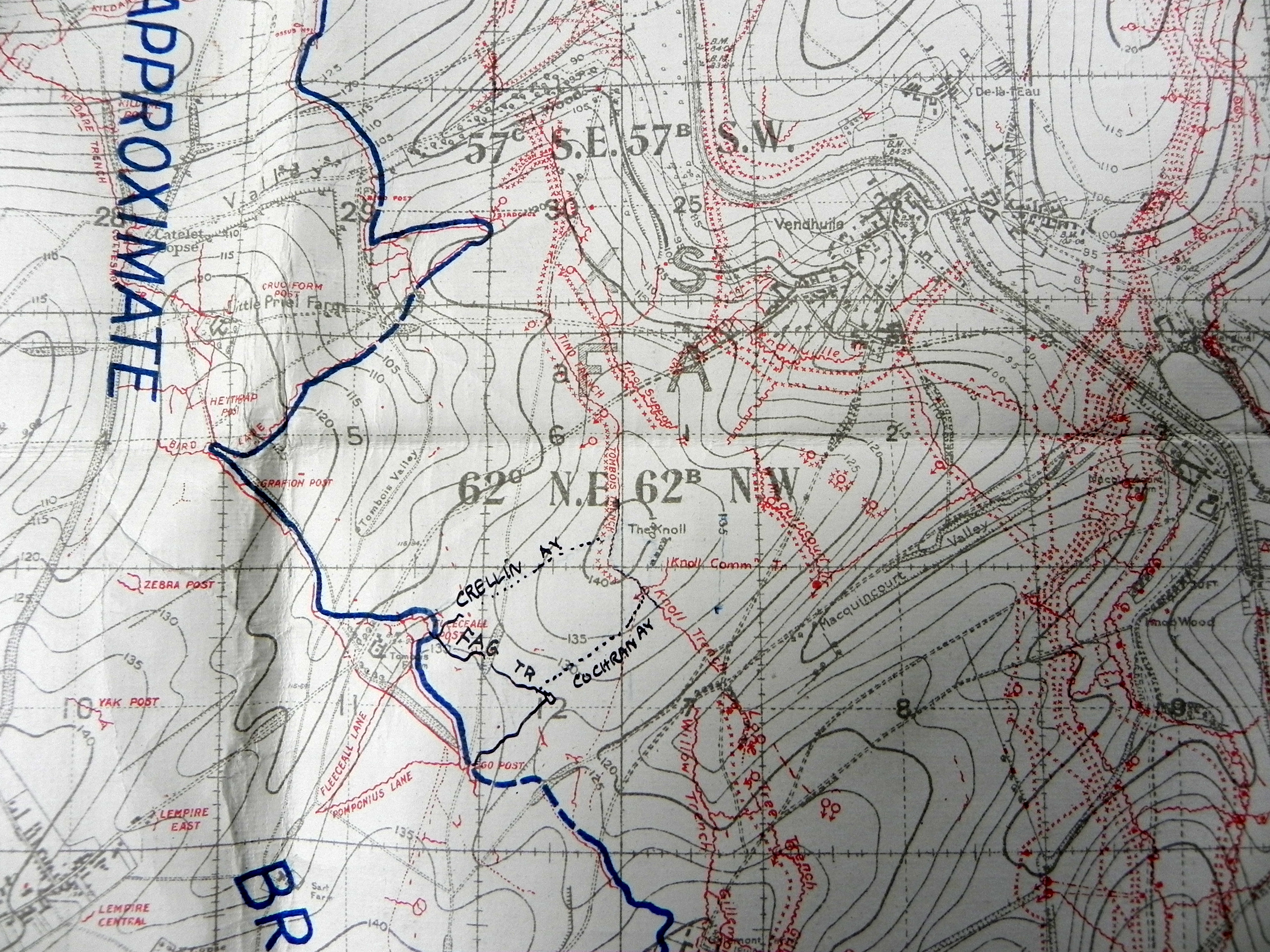
Trench map extract of The Knoll – captured by 105 Infantry Brigade on 19 August 1917
On 21 August 1917 near the village of Vendhuile in the eastern part of the Somme, Hardy’s battalion were holding recently captured trenches at a position known as The Knoll in the Hindenburg Line outpost zone. Their relief of the units who had captured the Knoll some two days before was completed by 1.30am that night.
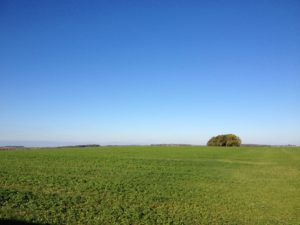
Modern view of The Knoll, photographed October 2017. Vendhuile, the Hindenburg Line and St Quentin Canal are out of view in the valley.
It was a critical position which afforded observation over the Hindenburg Line and St Quentin canal a mile away – observation the British wanted and the Germans wanted to prevent. In fact, men from Bristol’s 1/4th and 1/6th Territorial battalions had fought for the same view in this same position four months previously.
The loss of such critical terrain forced the Germans into a devastating counter-attack. As recorded in the Brigade war diary, at 3.51am the Germans struck. Militarily, it was a brilliantly executed counter-attack by the Germans – The Knoll being attacked at four points simultaneously. German infantry were accompanied by special detachments using portable flamethrowers. These forced Hardy Parsons’ men back. However, he alone stuck to his bombing post and held his position, throwing bombs (hand grenades) at approaching Germans until a British counter-attack could be launched. The counter-attack was successful – the Germans were repulsed from the trenches around The Knoll and within 40 minutes this bloody action was over. Much of this success is due to Hardy’s refusal to yield ground.
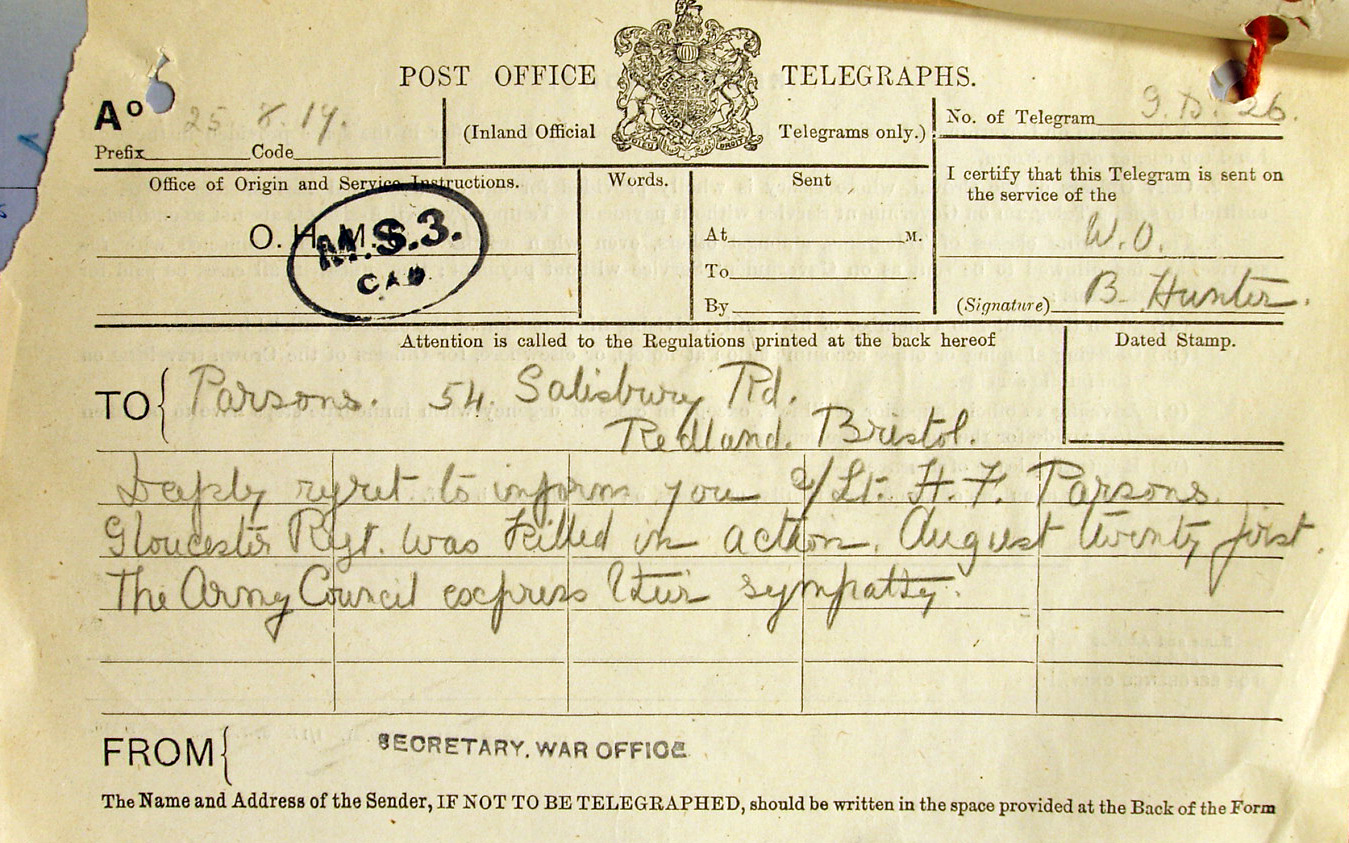
Telegram sent to the Rev James Ash Parsons informing him of Hardy’s death
During his heroic sole defence of The Knoll Hardy had been severely burnt by liquid fire. Writing these words over a hundred years later I cannot begin to imagine the sense of duty that compelled him to stay at his post, or the pain he would have endured during and after sustaining such horrific burns. Unsurprisingly, the nature of his wounds proved too severe and he succumbed later that day, dying at the age of just 20 years and two months. Hardy Falconer Parsons is buried in the immaculate CWGC cemetery at Villers-Faucon.
N.B. I was contacted in August 2019 by Dr Markus Schroeder whose great great uncle, Ernst Komander, served with the 2./Jäger 6, Jäger-Regiment 6, 195 Infanterie-Division. He tells me that regimental records show it was Jäger-Regiment 6 that led the attack on the 14th Gloucesters with the specialist flamethrowers employed by Sturmbataillon 3. Ernst Komander was wounded on the day of the attack and died of those wounds two days later. He is buried in Block 2, Grave 56 in Caudry German Military Cemetery.
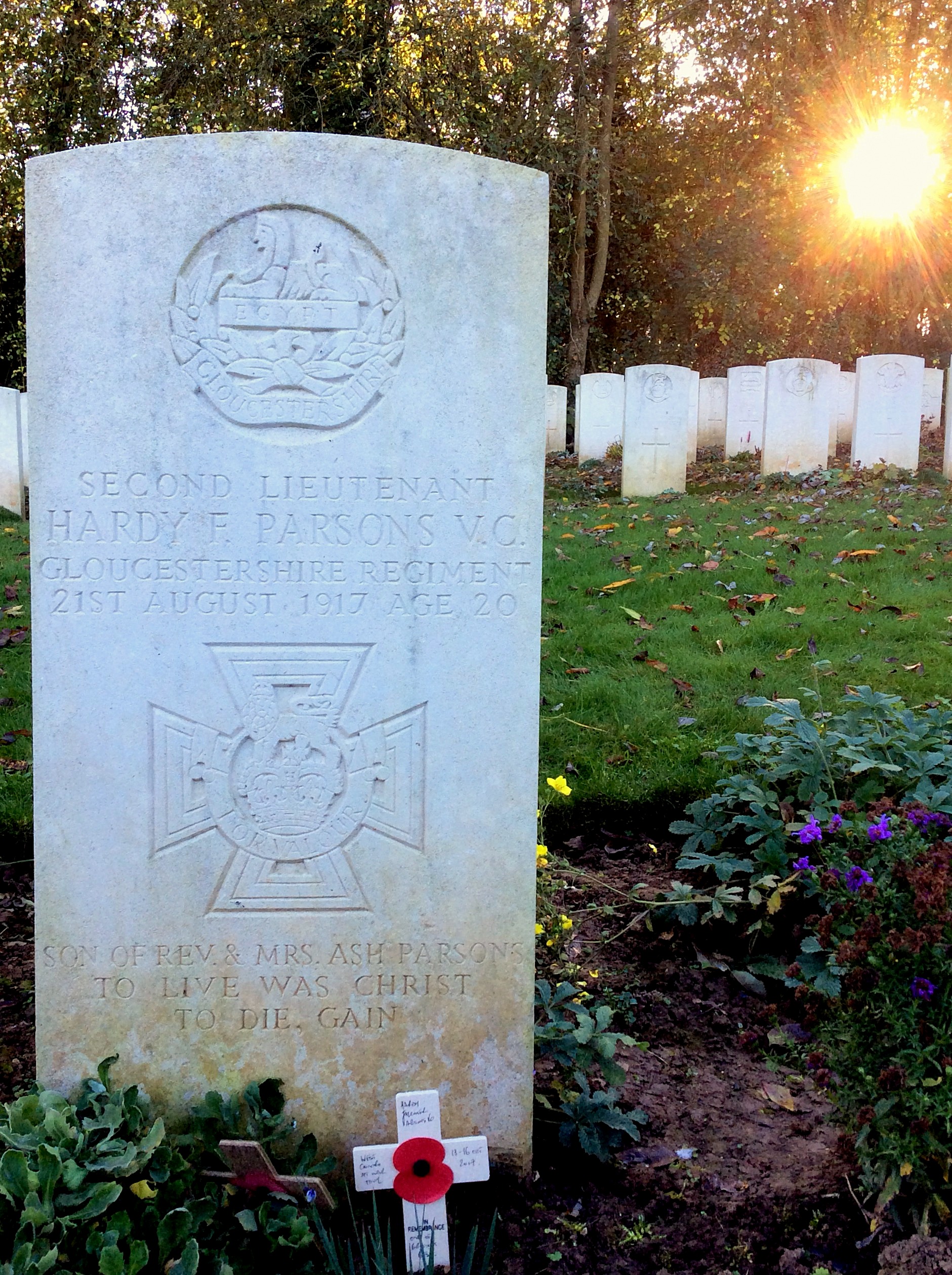
Grave of Hardy Falconer Parsons VC at Villers Faucon Communal Cemetery
Hardy’s effects, consisting of just a wrist ID disc and two wrist watches were sent by registered post to his father within the month.

105 Infantry Brigade war diary describing the events of 21 August 1917
The Brigade diary describes Hardy’s gallantry, commenting that he ‘was afterwards recommended for the VC for his action’. During the war many acts of bravery were put forward for the VC but subsequently rejected. However, in Hardy’s case, approval was given. He was posthumously awarded the Victoria Cross – personally presented to his father by King George V at a ceremony on Durdham Down (Bristol) on 8 November 1917. Hardy’s father also attended the Colston Hall event on 15 February 1919 when he was presented, on his dead son’s behalf, with an illuminated address and gold watch by Lord Mayor Twiggs. The address included Hardy’s full Victoria Cross citation:
“For most conspicuous bravery during a night attack by a strong party of the enemy on a bombing post held by his command. The bombers holding the block were forced back, but Second Lieutenant Parsons remained at his post, and, single-handed, and although severely scorched and burnt by liquid fire, he continued to hold up the enemy with bombs until severely wounded. This very gallant act of self-sacrifice and devotion to duty undoubtedly delayed the enemy long enough to allow the organisation of a bombing party, which succeeded in driving back the enemy before they could enter any portion of the trenches. This gallant officer succumbed to his wounds.”
Hardy Parsons was only the second member of the Gloucestershire Regiment to receive a VC during the First World War.
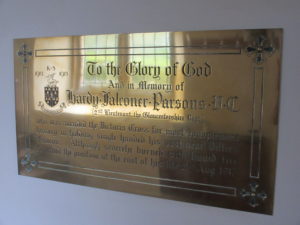
Hardy Falconer Parsons VC Chapel Memorial, Kingswood School, Bath
On 23 July 1923, a tablet in his memory was unveiled in the chapel of Kingswood School in Bath and his Victoria Cross and campaign medals are held by the Soldiers of Gloucestershire Museum, having been presented to the Gloucestershire Regiment at a ceremony in 1970 in front of what is now City Hall, attended by the Lord Mayor, Cllr Bert Wilcox.
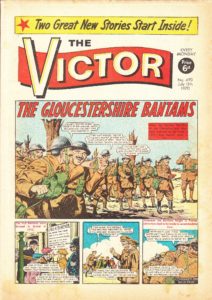
Victor comic, 11 July 1970 – the story of Hardy Falconer Parsons VC
The collection also includes a portrait photograph of Hardy in uniform; the bronze memorial plaque sent, popularly known as the “Dead Man’s Penny” to his parents after the war and his Gloucestershire Regiment collar badge. Engraved on the back of the badge are the words “Irene Randall 10 Newfoundland St., Bristol 1917”. Who she was, and why he had that, we will probably never know….
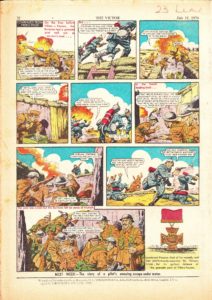
Victor comic, 11 July 1970 – the story of Hardy Falconer Parsons VC
On 11 July 1970, the Victor Comic ran a cartoon story with 10 sketches on its front and back pages, recounting the story of the 14th Gloucesters action at The Knoll and to the deeds of Hardy Falconer Parsons – bringing his heroic actions to the attention of a younger audience.
Ewart Moulton Parsons
And as for the Parsons family, despite Hardy’s death, the war had not finished with them. Hardy had two younger brothers; Ewart Moulton and Lyall Ash. Lyall was born too late to serve but Ewart, born the year after Hardy, was working as an apprentice engineer at Bristol company, Brecknell Munro and Rogers in summer 1916.
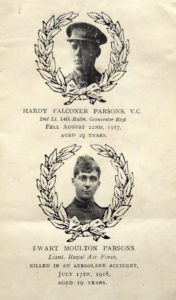
Page from memorial booklet for Hardy and Ewart Parsons
He joined the Royal Flying Corps in 1917 and by 17 July 1918, was a 19 year old Lieutenant and pilot in No.50 Training Depot Station at Eastbourne, flying his Sopwith F1 Camel fighter high above the Seaplane Station. What happened next is still unclear but his plane went into a spin and plummeted to the ground from 3000ft. Unsurprisingly, Ewart was killed instantly.
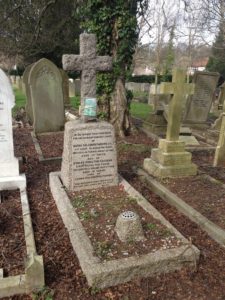
Grave of Ewart Parsons in Canford Cemetery, Bristol
His body was brought back to Bristol and his funeral held at the Old King Street Wesleyan Chapel where his father was the pastor. The coffin was borne by six RAF officers and taken on a gun carriage to Canford Cemetery, where the internment took place followed by the sounding of the Last Post.
So, in the space of eleven months James Ash and Rita Parsons had lost two of their three boys. On the base of the stone cross marking Ewart’s grave at Canford Cemetery the family also commemorated his brother, Hardy. Like so many families across the world, the Parsons’ suffered grievously in the war.
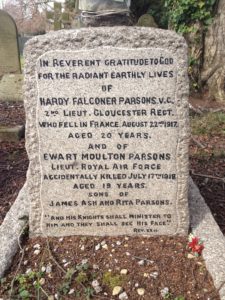
Detail on Ewart Parsons’ grave in Canford Cemetery
But, as this research is primarily based on Hardy I would like to end with a description of him, provided by his father which, when considered alongside his Victoria Cross action, shows him to have been a truly remarkable young man, a perfect example of the loss of the best of that generation:
“Hardy lived all of his life from early childhood on the same high plane of self-forgetfulness and sacrifice in his thought for and service of others”
Hardy Falconer Parsons VC (30 June 1897 – 21 August 1917)
Sources of information consulted for this article include:
Service record of Hardy Falconer Parsons VC (National Archives: WO339/73298)
105 Infantry Brigade War Diary (National Archives: WO95/2486)
14 Battalion Gloucestershire Regiment War Diary (National Archives: WO95/2486)
RAF service record of Ewart Moulton Parsons
Census returns (1901 & 1911)
Material from the Soldiers of Gloucestershire Museum http://www.soldiersofglos.com/
Victor Comic, 11 July 1970
London Gazette – various dates
The Kingswood Magazine, Vol. XX, No.10, December 1917
North Devon Journal, 27 August 1931
North Devon Journal, 10 November 1949
Gliddon, Gerald, VCs of the First World War: Cambrai 1917, Stroud, 2004

Second Lieutenant Hardy Falconer Parsons VC, 14th Gloucestershire Regiment. Image courtesy Soldiers of Gloucestershire Museum, Ref GLRRM:04750.6
On 8 November 2017 a Bristol Civic Society Blue Plaque for Hardy Falconer Parsons VC, 14th Gloucestershire Regiment (my local Victoria Cross recipient) will be unveiled at 54 Salisbury Road, Redland, Bristol. The date is 100 years to the day after King George V personally presented Hardy’s VC to his father, Rev James Ash Parsons at a ceremony on Durdham Downs.
Between 2014 and 2019 the Government is funding the production and placing of a commemorative stone for each and every Victoria Cross recipient of the First World War. Although Hardy Falconer Parsons lived at 54 Salisbury Road, he was not born in Bristol. So in August the government-funded commemorative stone relating to Hardy Parsons, was laid in Rishton, Lancashire.
Local historian and author Clive Burlton and I were determined to see Hardy’s strong association with Bristol and the West Country recognised. If we couldn’t have the government-funded stone in Bristol, the next best thing was to have a Bristol Blue plaque unveiled in his honour.
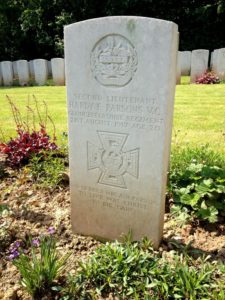
The grave of Hardy Falconer Parsons VC at Villers-Faucon Communal Cemetery
So, during the past year we have organised for the creation of the plaque. Wednesday’s ceremony, starting at 11am, will have representatives from the Bristol Civic Society; the former Gloucestershire Regiment; the Soldiers of Gloucestershire Museum; the Bristol University Officer Training Corps; Kingswood School, Bath, Redland Green School and Dolphin Schools in Bristol; bandsmen from the Salamanca Band of the Rifles Regiment; the Western Front Association; members of the Bristol Great War network and representatives of the Kingswood Association, whose generous donation enabled the plaque to be made and installed. Also attending are the Lord Mayor of Bristol, Cllr Lesley Alexander; the Deputy Lord-Lieutenant for the County and City of Bristol, Colonel Andrew Flint and the Dean of Bristol, the Very Rev Dr David Hoyle.
The event is open to the public so please do come along and attend if you can. I will be posting the results of my research on Hardy Parsons along with photos of Wednesday’s ceremony on my website later this week. In the meantime, it is worth reading Hardy’s VC citation to have an idea of his valour:
“For most conspicuous bravery during a night attack by a strong party of the enemy on a bombing post held by his command. The bombers holding the block were forced back, but Second Lieutenant Parsons remained at his post, and, single-handed, and although severely scorched and burnt by liquid fire, he continued to hold up the enemy with bombs until severely wounded. This very gallant act of self-sacrifice and devotion to duty undoubtedly delayed the enemy long enough to allow the organisation of a bombing party, which succeeded in driving back the enemy before they could enter any portion of the trenches. This gallant officer succumbed to his wounds.”
There should be a short film on Hardy’s action on Wednesday evening’s Points West (BBC1) from 6.30pm.
Bespoke battlefield tour walking in the footsteps of Corporal JT Davies VC, 11th South Lancashire Regiment
Earlier this month I spent an enjoyable time on the Somme with a client, Roland Parr, who was following in the footsteps of his great uncle, John Thomas Davies VC, 11th South Lancashire Regiment.
Roland had commissioned me to produce a detailed report on his great uncle in order that other family members could know more about this man, his war and the actions that led to the award of his Victoria Cross. Over the past few months Roland had accompanied me to the National Archives to look at war diaries from Division, Brigade and Battalion level. We also visited the Imperial War Museum to work in the Department of Documents and to have a good look at the new(ish) Lord Ashcroft Gallery which holds the original VC of Jack Davies. It must have been a somewhat surreal experience for Roland to be looking at the actual VC in its hermetically sealed case when he remembers holding the medal as a young boy.
All of this was the precursor to our visit to the battlefields to follow ‘Uncle Jack’ around the western front.
We set out from Peronne and began our pilgrimage at Maricourt, a village that Jack Davies and the rest of the 11th South Lancs would have known well from their time here in 1916. The battalion were the Pioneers to the 30th Division. I had found a map showing the trenches in this sector dug by the battalion during the month of July 1916. I also noted that they had opened out some of the Russian saps dug by men of 183 Tunnelling Company RE. All of these sites could be viewed in the fields in front of us.
We stood at the site of the British front line on the quiet road to Montauban with Machine Gun Wood on our left and Germans’ Wood to our front right and imagined what this scene looked like on 1 July and the subsequent days and weeks as battle moved on in this area.

Panorama from British front line looking towards the village of Montauban on the right hand side - an objective for the 30th Division. Machine Gun Wood can be seen on the left of frame.
After Montauban we stopped at the 18th (Eastern) Division memorial at Trones Wood. The 11th South Lancs had been working in the wood in the latter half of July 1916.
We then spent a pleasant few hours on a tour of the battlefields – all south of the Ancre. Stops included High Wood, Ulster Tower and the Pope’s Nose and the Thiepval Memorial. I was also able to give Roland a good look around the Glory Hole at La Boisselle.
After stocking up on a picnic lunch at the Old Blighty Tea Room at La Boisselle we headed back to Peronne and then down to St Quentin, focussing on the period from the German attack on 21 March 1918 through to the action for which Jack Davies was awarded his VC on the morning of 24 March. We visited the villages of Savy, Roupy and the small site of Epine de Ballon. Jack’s company (unknown) was in one of these locations prior to the German offensive. We then made our way to Fluquieres and from there to the high ground between Aviation Wood and Mill Wood. On the evening of 21 March 1918 the battalion dug and wired a defensive line through here, remaining for nearly 24 hours until on the evening of 22 March the order was given for all troops to withdraw in orderly fashion to Ham. Upon reaching Ham the battalion was told to billet in nearby Eppeville. We had a good look around Ham, visiting the bridge over the Somme Canal blown up by a detachment of Royal Engineers on the morning of the 23rd before driving west to Eppeville itself.

The bridge over the Somme Canal at Ham blown up by a detachment of RE on the morning of the 23 March 1918
This was the village, really no more than one street, intrinsically tied to Jack Davies’s VC story. After stopping at the Sucrerie (ironically now owned by a German company called Südzucker, the largest sugar producer in Europe) we continued west and crossed the railway line, noting the positions held along the line by the battalion.
Finally, we reached the field where two companies of the battalion were almost entirely surrounded on the morning of 24 March 1918. As is the way with so many sights of unimaginable bravery in the Great War there is nothing to mark the site as anywhere special – just a couple of grassy fields next to the road with a man-made lake behind them barring the way to the stream over which the survivors escaped.
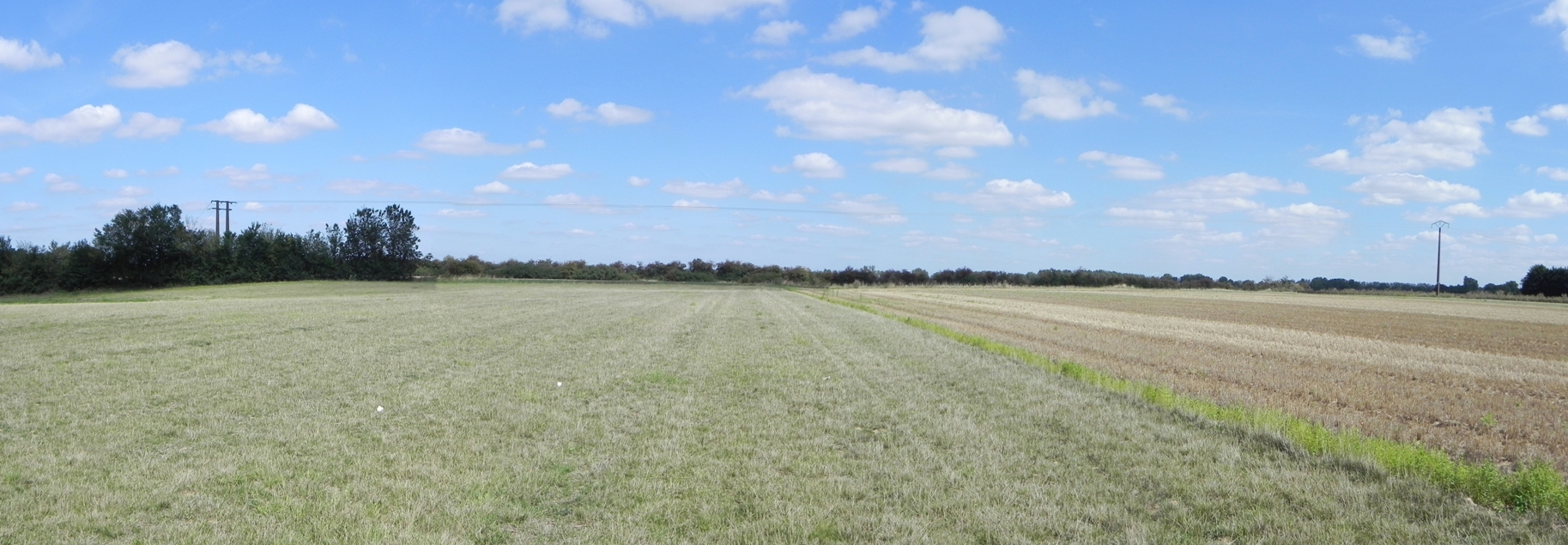
The field where Jack Davies performed the deeds which led to his VC award. German troops had crossed the canal and were coming directly towards this spot.
According to the after-action report compiled in the war diary it was in these two innocuous fields that Jack Davies mounted the parapet and kept his Lewis Gun firing until overwhelmed by the advancing Germans.
For most conspicuous bravery and devotion to duty under heavy rifle and machinegun fire. When his company – outflanked on both sides – received orders to withdraw, Corporal Davies knew that the only line of withdrawal lay through a deep stream lined with a belt of barbed wire, and that it was imperative to hold up the enemy as long as possible.
He mounted the parapet, fully exposing himself, in order to get a more effective field of fire, and kept his Lewis gun in action to the last, causing the enemy many casualties and checking their advance. By his very great devotion to duty he enabled part of his company to get across the river, which they would otherwise have been unable to do, thus undoubtedly saving the lives of many of his comrades. When last seen this gallant N.C.O. was still firing his gun, with the enemy close on the top of him, and was in all probability killed at his gun.
Quite how and why he wasn’t killed remains unknown but it was only two months later, after his VC citation had been published in the London Gazette that word reached home that he was a POW in Germany. It was safely assumed that Jack was killed in the action and so the citation (above) is written as a posthumous record of his bravery.
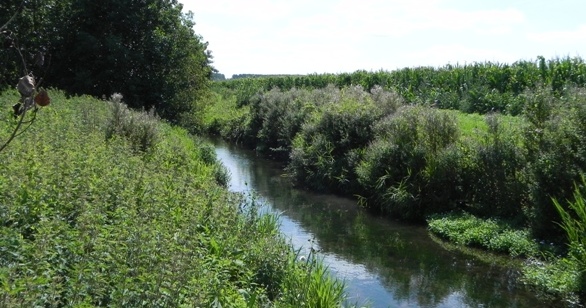
The "deep stream lined with a belt of barbed wire" over which the survivors of the 11th South Lancs escaped - now called the River d'Allemagne.
Roland laid a small cross in the field and we then paid our respects at Ham British Cemetery where other men of the 11th South Lancs who hadn’t the same luck as Jack are buried. It was a spot I hadn’t visited before and I was taken by the two cemeteries – the British and Commonwealth cemetery directly next to the Muille-Villette German Cemetery.

Ham British Cemetery. The black crosses of the neighbouring German cemetery can just be made out above the Portland stone headstones.

A view from the German cemetery - the gravestones of German and British soldiers lie almost side-by-side.
Before leaving I laid a cross at the grave of Lieutenant John Cuthbert Lidgett, 11th South Lancs in memory of all the men of the battalion who made the ultimate sacrifice. It had been a real trip to remember….
“What a wonderful day you provided for me, far exceeding my expectations for our time together. I mentioned the words ‘bringing alive’ and certainly you did that both for the 1 July 1916 action on the Somme and also Jack’s story from 21-24 March 1918. I have no idea how many similar stories you have so far put together, but I cannot think that anyone trying to trace the steps of a long lost relative would regret having made contact with you. If this is the source of your livelihood, then I can see nothing but success ahead.” Roland Parr, Cambridge
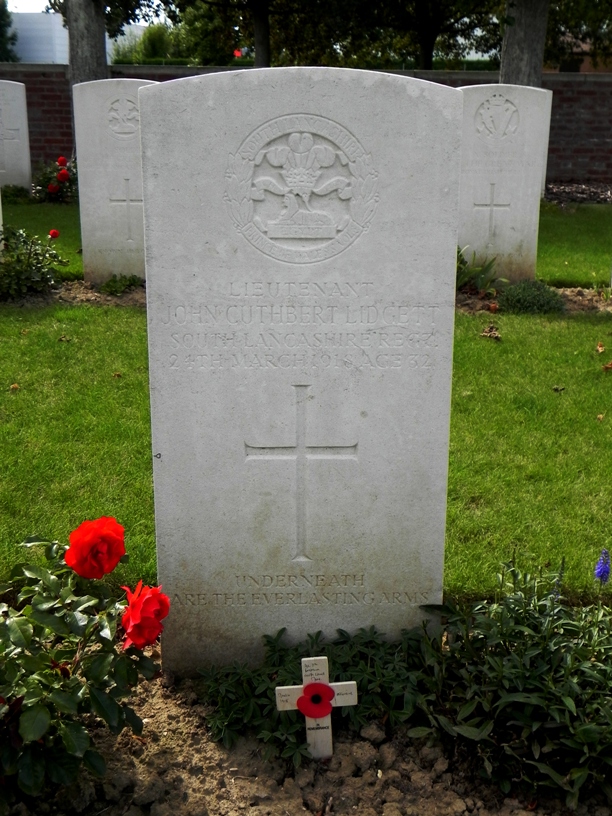
The grave of Lieutenant John Cuthbert Lidgett, 11th South Lancs in Ham British Cemetery. The cross was placed in memory of all the men of the battalion who made the ultimate sacrifice.
What a wonderful day you provided for me, far exceeding my expectations for our time together. I mentioned the words ‘bringing alive’ and certainly you did that both for the 1 July 1916 action on the Somme and also Jack’s story from 21-24 March 1918. I have no idea how many similar stories you have so far put together, but I cannot think that anyone trying to trace the steps of a long lost relative would regret having made contact with you. If this is the source of your livelihood, then I can see nothing but success ahead.
Roland Parr,
I had a few much-needed days rest with the family at a cottage in Devon last week. We were blessed with beautiful weather and a good time was had by all. Most importantly I came back rested and restored after a busy time over the past few months.
I had wanted to visit Plymouth, my old university city, for some time, not only to see how it looked nowadays but to go to The Hoe and visit the Plymouth Naval War Memorial. I can well remember the memorial from my student days but gave it little thought back then. Twenty years older and perhaps a little wiser I wanted to pay my respects at the name of one man whose story I had looked into – Able Seaman Daniel Collins. Daniel was the younger brother of Thomas Collins, the man Sapper William Hackett refused to leave 40 feet below the fields of Givenchy – an act for which Hackett was awarded a posthumous Victoria Cross. He was the only tunneller ever to receive the award and he and Thomas Collins lie there still.
Able Seaman Daniel Collins, RNVR was killed on 26 February 1918 on “SS Greavesash”, a merchant steamer which was torpedoed without warning by German submarine UB-74 and sunk off the Normandy coast. Daniel was one of eight crew who were killed that day. Whilst visiting Thomas and Daniel’s nephew, John Abraham back in March 2010 I had been struck by the loss of the two eldest Collins boys in the war and could only imagine the effect that this had on the family.
The memorial is very imposing and is situated centrally on The Hoe overlooking Plymouth Sound. It commemorates 7,251 sailors of the First World War and 15,933 of the Second World War. The panels bearing the rank and names of sailors who were lost at sea are organized by date so I had to walk around the entire memorial from 1914 through to 1918 until I came to Panel 29 which contained the names of officers and men of the Royal Naval Volunteer Reserve. The names, as per the various Memorials to the Missing on the Western Front are organised by rank and it was to the bottom right of the panel that I spotted the men who had the rank of Able Seaman; the third name down was “COLLINS D.”
Able Seaman Daniel Collins, RNVR – like your brother Thomas, gone but not  forgotten.
forgotten.

I was lucky enough to be invited to the launch of the new Victoria Cross Gallery at the Royal Engineers Museum on 11 November. The exhibition opened to the public on 12 November but, along with about a hundred others, got a sneak preview. The exhibition celebrates the twenty five Victoria Crosses that the Museum holds as well as giving details for a further thirty RE VCs not in the museum collection. BBC Kent covered this story HERE.
Prior to the opening we were all lucky enough to see the ORIGINAL Victoria Crosses in a display box – I was informed that a cost estimate for the box was about £10 million.
It was terrific to see medals – from some of the earliest medal from the Crimean War, Boer War (Lieutenant Digby Jones who was the first man to be awarded the VC posthumously) through to the Second World War and that of Sergeant Thomas Durrant, awarded posthumously following his actions in the St Nazaire raid of 1942; his bravery was so great his captors insisted he receive a bravery award.
However, it was the Great War VCs that I had really come to see and I was not disappointed. Amongst those on display along with unseen archival material, personal items, and weaponry were the three Royal Engineers whose VC action was on the same day – 4 November 1918 when crossing the Sambre-Oise canal; Sapper Adam Archibald VC, 218 Field Company, Major George de Cardonnel Elmsall Findlay VC, MC & Bar, 409 (Lowland) Field Company and Major Arnold Horace Santo Waters VC, 218 Field Company.
Major James McCudden, Gillingham’s own VC recipient, whose medals are on display alongside those of his two brothers (who sadly both also died in WW1) and his father’s (who died shortly after WW1).
My main interest was to see an addition to the museum’s collection of the story of Sapper William Hackett. I had tracked down descendants of Thomas Collins, the man Willam Hackett refused to leave under the fields of Givenchy-lès-la-Bassée in June 1916. This BBC Wales news item shows the picture of Thomas that hung over his mother’s fireplace until her death. It had been arranged between the family descendants and the RE Museum that this picture would go to the museum – after all, Collins is instrumental to the Hackett’s VC action. I was delighted to see Terry Carroll there, nephew of Thomas Collins, who I had met at the Tunnellers Memorial unveiling in June. He was delighted and understandably moved to see the picture of Uncle Tommy, a picture he knew so well from his childhood, restored, cleaned and hanging in such illustrious company in the RE Museum.
There is a Remembrance book in the Medals room, specifically for people to record their memories of members of their family who have served in the armed forces. The exhibition is now open to all visitors – it is highly recommended. Well done to the museum staff who have done such a fine job with this exhibition. The braveryof the men who earned these awards is, as ever, staggering.
The museum can be found on Prince Arthur Road, Gillingham, Kent, ME4 4UG. Telephone 01634 822839 or website www.remuseum.org.uk

